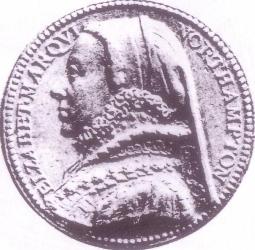Elisabeth Brooke, Marchioness of Northampton facts for kids

Elisabeth Brooke (born June 25, 1526 – died April 2, 1565) was an important English noblewoman and courtier. She was the oldest daughter of George Brooke, 9th Baron Cobham and Anne Braye. Elisabeth was known for being lively, kind, and one of the most beautiful women at court.
Her relationship with William Parr, 1st Marquess of Northampton, who was the brother of Catherine Parr (King Henry VIII's last wife), played a big role in English politics for many years. As the Marchioness of Northampton, Elisabeth often took on duties similar to a queen during the time King Edward VI ruled. Her husband was key in trying to place Lady Jane Grey on the throne. When Mary I became queen, William Parr was imprisoned and lost his titles. Later, during the reign of Queen Elizabeth I, Elisabeth became one of the most influential people at court once more.
Life at King Henry VIII's Court
Elisabeth Brooke arrived at King Henry VIII's court when she was about 14 years old. She served as a maid-of-honour to Queen Katherine Howard. Some people even thought she might become King Henry's next wife.
Elisabeth became close with William Parr. William was a good friend of Henry VIII's son, Henry Fitzroy. William Parr was already married to Anne Bourchier, but their marriage was not happy. At this time, King Henry chose William's sister, Catherine Parr, to be his sixth wife. This made William very popular at court.
Even though King Henry had ended four of his own marriages, it was very difficult for regular people to get a divorce. William Parr wanted to end his marriage to Anne, but the law made it impossible for him to marry someone else.
During King Edward VI's Reign
After King Henry VIII died, William Parr asked the new king, Edward VI, for permission to divorce and remarry. However, Edward Seymour, 1st Duke of Somerset, who was the powerful Lord Protector (a kind of regent for the young king), said no. Elisabeth was sent to live with Catherine Parr in Chelsea. Princess Elizabeth and Lady Jane Grey also lived in Catherine Parr's household.
Catherine Parr later married Sir Thomas Seymour, but she passed away in September 1548. This meant that William Parr's influence at court became less strong.
In 1549, a political change happened. John Dudley, 1st Duke of Northumberland, a close friend of William Parr, took over as the main power in England. On March 31, 1551, a special law was passed by Parliament. This law officially ended William Parr's marriage to Anne Bourchier. It also recognized Elisabeth Brooke as his legal wife. The couple then made their home together at Winchester House, Southwark.
The Northamptons enjoyed social events and sports. They liked playing cards, watching bear baiting, and attending plays and musical shows.
Under Queens Mary I and Elizabeth I
When Mary I became queen in 1553, William Parr was ordered to go back to his first wife, Anne. Both Elisabeth and her father, Lord Cobham, had supported Lady Jane Grey's claim to the throne instead of Mary's. There are hints that Elisabeth continued to work against Queen Mary and for Princess Elizabeth.
When Queen Mary I died and Elizabeth became queen of England, William Parr's titles were given back to him. His divorce and remarriage to Elisabeth were also accepted. The Marchioness Elisabeth became very close to Queen Elizabeth I. People said her influence was as strong as Robert Dudley's, another important courtier. Many letters from this time talk about Elisabeth's illness, showing how important she was. Ambassadors from Sweden and Spain tried to win her support for their countries.
By 1564, Elisabeth was very ill with breast cancer. She desperately wanted to find a cure. With her brother and sister-in-law, she traveled to the Netherlands to look for treatment. Doctors from all over Europe tried to help her. Queen Elizabeth even arranged for the personal doctor of the King of Bohemia to visit Elisabeth in England.
Elisabeth died on April 2, 1565, when she was about 39 years old. She had a lot of debt. Queen Elizabeth was very sad about her death. Five years later, William Parr married a 16-year-old Swedish woman named Helena Snakenborg. She was said to look a lot like Elisabeth. William Parr died soon after.

